A Quantitative Study of Litter and Soil Invertebrates - Association for ...
A Quantitative Study of Litter and Soil Invertebrates - Association for ...
A Quantitative Study of Litter and Soil Invertebrates - Association for ...
You also want an ePaper? Increase the reach of your titles
YUMPU automatically turns print PDFs into web optimized ePapers that Google loves.
74<br />
<strong>Litter</strong> <strong>and</strong> <strong>Soil</strong> <strong>Invertebrates</strong><br />
Contents<br />
Introduction....................................................................................................................74<br />
Student Outline ..............................................................................................................76<br />
<strong>Litter</strong> <strong>and</strong> <strong>Soil</strong> <strong>Invertebrates</strong> ..........................................................................................76<br />
Supplementary Instructions ...........................................................................................77<br />
Tally Sheet .....................................................................................................................79<br />
Notes <strong>for</strong> the Instructor ..................................................................................................80<br />
Preliminary Preparations................................................................................................80<br />
Sample Site <strong>and</strong> Sample-Taking Procedure...................................................................82<br />
Analysis <strong>of</strong> the Sample ..................................................................................................83<br />
The Living “<strong>Litter</strong> S<strong>and</strong>wich” .......................................................................................85<br />
Literature Cited <strong>and</strong> Further Reading ............................................................................88<br />
Appendix A: Representative <strong>Litter</strong>-<strong>Soil</strong> <strong>Invertebrates</strong> ..................................................89<br />
Introduction<br />
Why should anyone study the organisms <strong>of</strong> litter <strong>and</strong> soil? Is there any reason to be interested<br />
in the animals that inhabit the lawn we walk on or that live in the organic debris <strong>of</strong> the <strong>for</strong>est<br />
floor? For at least two reasons, the answer is “yes.” Firstly, if there were no decomposer<br />
community, grass clippings remaining on the lawn <strong>and</strong> leaves shed in the <strong>for</strong>est would accumulate<br />
indefinitely. Eventually, that accumulation would drastically alter the environment. A little<br />
reflection reveals, also, that growing things would soon run out <strong>of</strong> nutrients without the recycling<br />
<strong>of</strong> resources. The debris-covered surfaces <strong>of</strong> the earth, both terrestrial <strong>and</strong> aquatic, would change<br />
dramatically without decomposer microorganisms, like bacteria <strong>and</strong> fungi, <strong>and</strong> invertebrate<br />
animals.<br />
Secondly, arthropods are the dominant animal group throughout the world. They are nowhere<br />
more readily seen in diverse <strong>for</strong>ms <strong>and</strong> high numbers than in litter <strong>and</strong> soil. Although insects <strong>and</strong><br />
arachnids usually dominate the scene, seven classes <strong>of</strong> arthropods may be seen in a single sample.<br />
And, their abundance bespeaks their importance. Arthropods, generally, are viewed as regulators<br />
<strong>of</strong> decomposition, accelerating or delaying nutrient release from decomposing organic matter<br />
(Mattson, 1977). Studies <strong>of</strong> litter-soil organisms, there<strong>for</strong>e, permit easy, direct approaches to<br />
biological processes integral to life in virtually any natural situation. Such studies should be<br />
included in the students' repertory <strong>of</strong> critical experience.<br />
The primary objective <strong>of</strong> this exercise is to acquaint students, at several pr<strong>of</strong>iciency levels,<br />
with invertebrates that inhabit the litter-soil zone. Briefly, the exercise entails collecting the<br />
organic matter from a measured surface area <strong>of</strong> soil, utilizing the Berlese Funnel method <strong>for</strong><br />
extraction <strong>of</strong> animals from the sample, <strong>and</strong> studying these organisms <strong>for</strong> identification to major<br />
groups <strong>and</strong> other observations. In the process <strong>of</strong> preparation <strong>of</strong> the exercise, the instructor who<br />
has not had previous exposure to invertebrates in this way may be exposed to new vistas <strong>of</strong><br />
in<strong>for</strong>mation <strong>and</strong> recognize fresh research possibilities.<br />
Perhaps the most logical place <strong>for</strong> this exercise is in the laboratory portion <strong>of</strong> an introductory<br />
biology course in a segment that deals with animals. <strong>Litter</strong>-soil organisms are <strong>of</strong> such a diversity<br />
<strong>of</strong> size, number, <strong>and</strong> kind that several kinds <strong>of</strong> in<strong>for</strong>mation (identification <strong>of</strong> common groups, size<br />
<strong>and</strong> number relationships) can be addressed in one unit. Sophomore/junior invertebrate zoology<br />
courses can extend the basic recognition <strong>and</strong> density determinations <strong>of</strong> specimens to observations<br />
<strong>of</strong> morphological adaptation to the environment, <strong>and</strong> correlation to life history stages with habitat<br />
<strong>and</strong> seasons. Ecology classes may attempt to determine the roles played by dominant organisms,
















